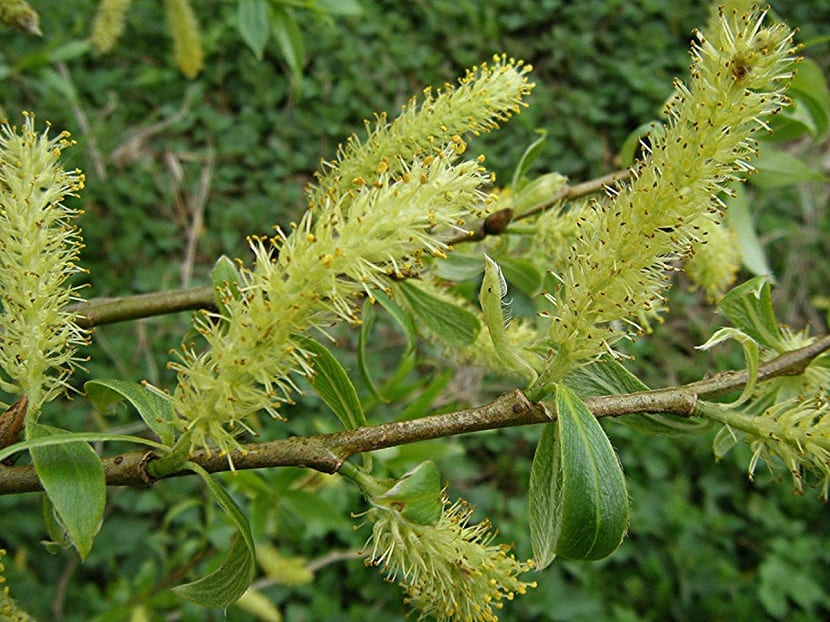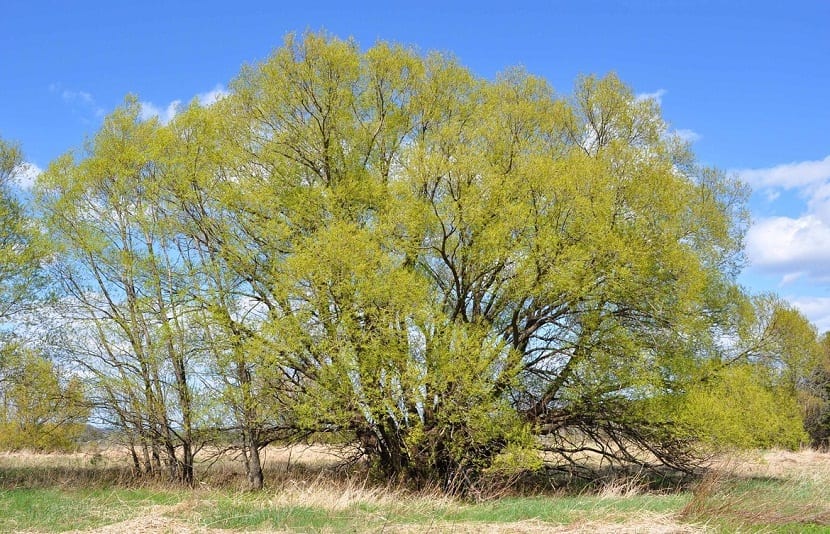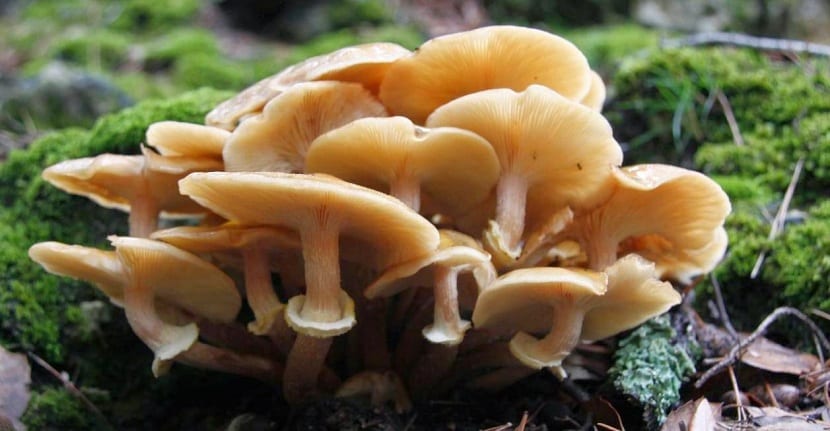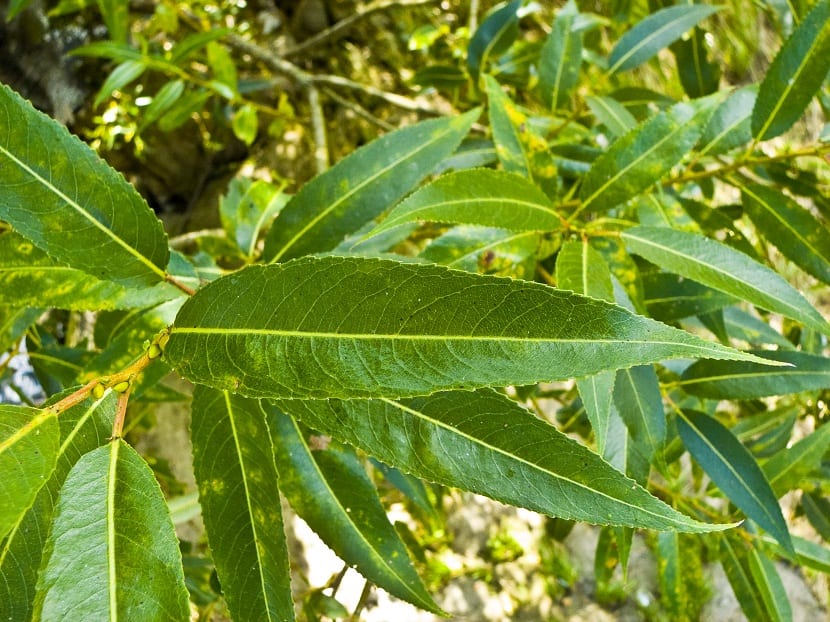
El salix fragilis It is a tree of the Salicacea family and of the genus Salix, commonly known as brittle wicker. It is a species that can be easily adapted to various soil and temperature conditions, with the ability to spread in wide spaces along riverbanks thanks to its vegetative reproduction. Its name is because sIts branches are easily detached since its condition as an invasive plant can generate a great economic, environmental, biodiversity and social impact.
Origin of salix fragilis

This species of willow is believed to be native to southern and central Europe, spreading from Spain to Latvia, through Belarus to Greece, including western Russia and western Asia or Eurasia represented by Turkey. Nevertheless its exact origin is still unknown due to confusion with the Salix x Rubens.
Features
El salix fragilis show a lush, fairly thick green crown that frequently acquires a distinguished disposition. Often the willows more long-lived they have a hairy appearance. This plant can live up to 80 years, being able to reach an approximate height of 25 meters and a diameter of 15 during its existence.
Its bark is ribbed which is accentuated over the years, is grayish-brown in color. Sometimes you can see willows with three or more trunks that usually arise from the same point.
Its erect branches are slightly hanging and smooth. Light brown with shades ranging from yellow to olive. Its leaves are elongated, narrow, lanceolate, 10 centimeters long and 2 wide. They are soft and thick, while the young leaves are a bit more sensitive and somewhat sticky. The color of its leaves remains green in early autumn.
It is a dioecious species for being the masculine and feminine flowers in different trees. Its flowers are like its name, fragile and flowering occurs practically along with the foliage. The color is between greenish and yellow as a result of the enormous amount of stamens. Its flowers are highly desired by the bees.
Plantation
El salix fragilis it multiplies through its entire branches and in this the wind plays an important role, which easily breaks the branches of the young shoots. When their branches fall in moist soil, they develop their roots and give birth to new trees..
In its wild habitat, large specimens can be seen, the fragility of its branches is useful for gardeners who grow it in gardens and reproduction by cuttings is quite simple, so you can choose a branch, you place it directly in the ground and quickly in two weeks it takes root.
At three years can reach a height of 3 to 4 meters, showing a large crown that can measure up to 2.5 meters in width. When it is five years old, it will reach 10 meters in height and if you have not pruned it yet, its crown can extend up to 8 meters in width.
This plant is preferable that you cultivate in spaces near water sources such as rivers or freshwater lakes. It grows well in humid regions and during spring rains tolerates possible floodingIn addition, and in relation to sun exposure, full or partial shade exposure is better.
It is a species that adapts to almost any type of soil, this can be sandstone, clayey, as long as it is fertile. When planting willow in heavy clay soils, it is good to combine it with a layer of sand that is only 30 inches thick. What the suckers do require is abundant watering.
Care

Just as easy is its cultivation, the same happens with the care of the plant, for that reason and if you have planted the tree in a place far from the wetlands, We recommend that you provide it with moisture through frequent and abundant wateringsAlso, during the hottest days, try to spray your crown with enough water.
Regarding fertilization, willows usually do not need it, unless you observe that there is not a good growth of the shoots. If you notice that its development is not as expected, you can apply an appropriate fertilizerSo a soil test can indicate the existing nutrient levels so you can determine the right specific fertilizer.
In relation to pruning it is important that you eliminate dry, diseased or deteriorated shoots. To achieve a better image of the tree, usually cut its crown. You can also secure the young specimens to an object, such as a peg to give it more stability and protect them from the vicissitudes of the wind.
Diseases and pests
This tree of majestic foliage it is sensitive to the attack of a good number of pests. In the Salix you can find dozens of parasites of all kinds, among which we can mention the poplar hawk moth (popular laothoe), mountain sweepers, a group of arthropod insects and beetles, which must be dislodged through the application of appropriate insecticides.
In addition to these annoying parasites that can be seen with the naked eye, there are others that are not so visible, microscopic bacteria and a variety of fungi. This pest attacks the various parts of the tree, such as its roots, stems, branches, leaves and flowers. Fungal diseases are not easy to fight and eliminate, can damage the plant to cause its necrosis.

Sometimes dark tips form on the tubers, while in spring they can be seen on its branches as small frozen yellow or reddish drops. The preventive treatment of fungal diseases is through the use of antifungal agents applied during the fall and spring.
Uses

El salix fragilis It is used in the decoration of both natural and artificial ponds and thanks to its ability to provide good shade, are planted in parks and gardens to create shady spaces. As it is a honey-producing plant, it is grown near the bee hives.
This lush tree is frequently used in construction sites. This is mainly due to its strong wood and the dizzying growth of wood pulp. It is also used in the elaboration of handicraft objects.
For its known medicinal properties, brittle wicker is used in traditional medicine. Its bark and leaves contain tannins, flavonoids, salicin and others. It is used in the treatment of diseases such as rheumatism and osteochondrosis that affects children and young people, infectious states and nervous disorders, digestive bleeding and uterine bleeding. It is also used as an anthelmintic, antipyretic, diuretic and choleretic.